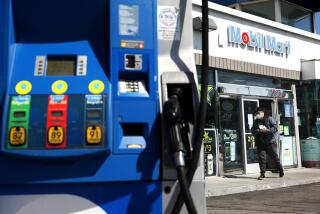Industry Opposes Push for Anti-Alcohol Ad Campaign
- Share via
The alcohol industry has launched a vigorous counteroffensive to a move afoot in Congress to include anti-alcohol messages as part of the federal government’s five-year, $1-billion youth anti-drug advertising blitz.
Efforts to include more ads against underage drinking began when Rep. Lucille Roybal-Allard (D-Los Angeles), concerned about high rates of problem drinking among Mexican American men, questioned why alcohol messages are not part of the government’s paid media efforts to combat substance abuse.
Today, the congresswoman is expected to introduce an amendment in a House Appropriations subcommittee to require that messages against excessive underage drinking be part of the campaign.
David Rehr, senior vice president of the National Beer Wholesalers Assn., lobbied subcommittee members Wednesday to vote against the expected amendment.
“Everyone wants to get rid of underage drinking,” but the alcohol industry is best suited to formulate and distribute that message, Rehr said. “Tax dollars shouldn’t be used to put out of business a legal product.”
Launched with fanfare last year, the Youth Anti-Drug Media Campaign has provided a steady drumbeat of ads aimed at adolescents and their parents that propound the dangers of illegal drug use. It is part of a government effort to reduce youth drug use 20% by 2002. Currently, officials said, an estimated 95% of teens see or hear seven such messages each week.
Yet none of the paid ads deal with alcohol abuse, a problem that studies show afflicts four times as many Americans as drug abuse.
At a March 25 hearing, Roybal-Allard, head of the Congressional Hispanic Caucus, asked why alcohol isn’t being tackled in the campaign. Citing two recent articles in The Times, she noted the disproportionate toll of heavy alcohol use and abuse on Mexican American men and quizzed the White House anti-drug czar, Gen. Barry R. McCaffrey, about what his White House Office of National Drug Control Policy is doing to tackle the issue.
“The problem,” Roybal-Allard told McCaffrey, “has grown to epidemic proportions and is threatening many of our Mexican American communities, such as those in my congressional district.” Heavy problem drinking, according to a 1998 federal study, is one-third higher among Mexican American men than among any other ethnic subgroup surveyed.
McCaffrey’s office says it hasn’t included anti-alcohol messages because it lacks the legal authority to do so. The agency added that media outlets paid to put out the ads must air an equivalent amount of free public service announcements about substance abuse, of which 15% are about alcohol or drunken driving.
Advocates for making alcohol a bigger part of the campaign say alcohol abuse is as great a menace to youths as abuse of other drugs.
McCaffrey himself has said that “the most dangerous drug in America today is still alcohol” and cited its role in 100,000 deaths and $150 billion in socioeconomic and medical costs each year.
More to Read
Sign up for Essential California
The most important California stories and recommendations in your inbox every morning.
You may occasionally receive promotional content from the Los Angeles Times.










